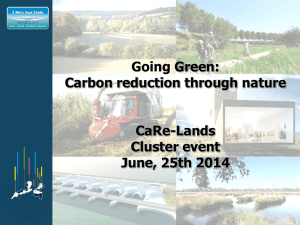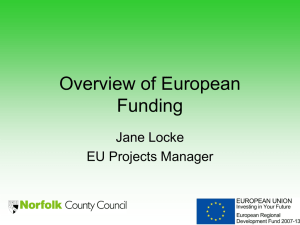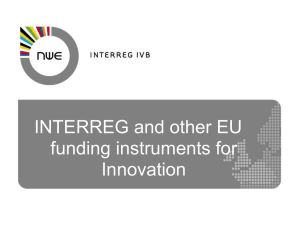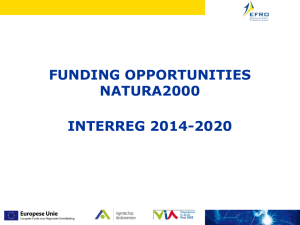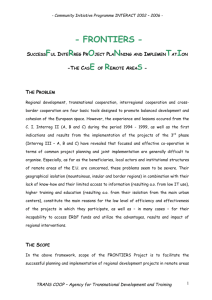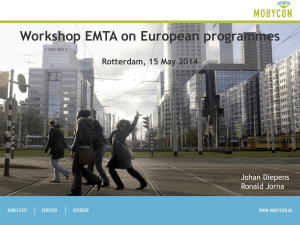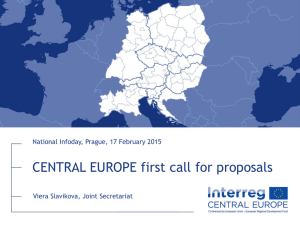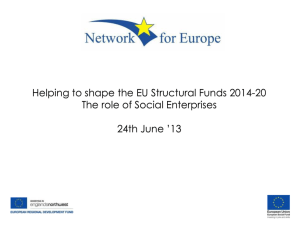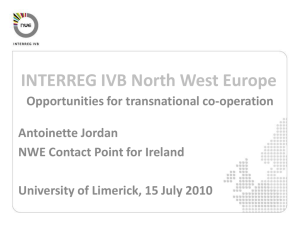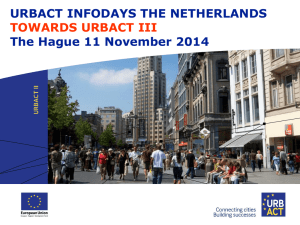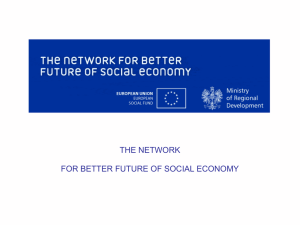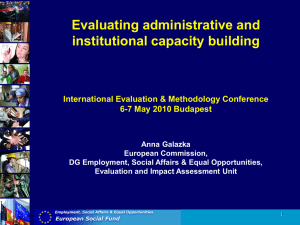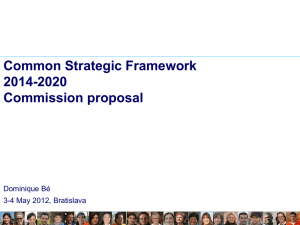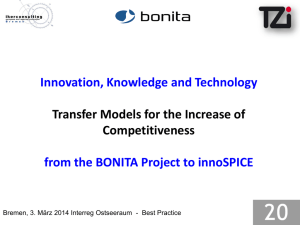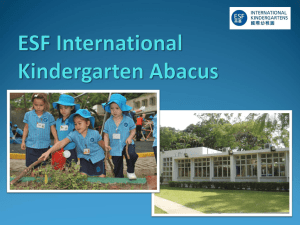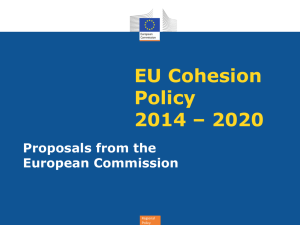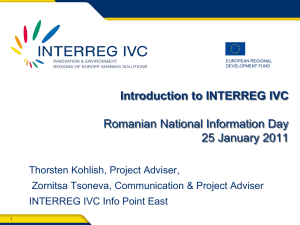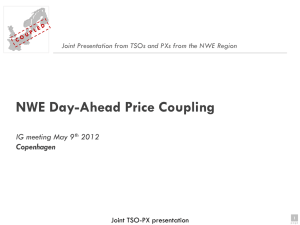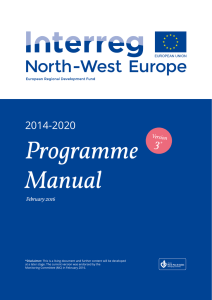INTERREG IVB North West Europe
advertisement
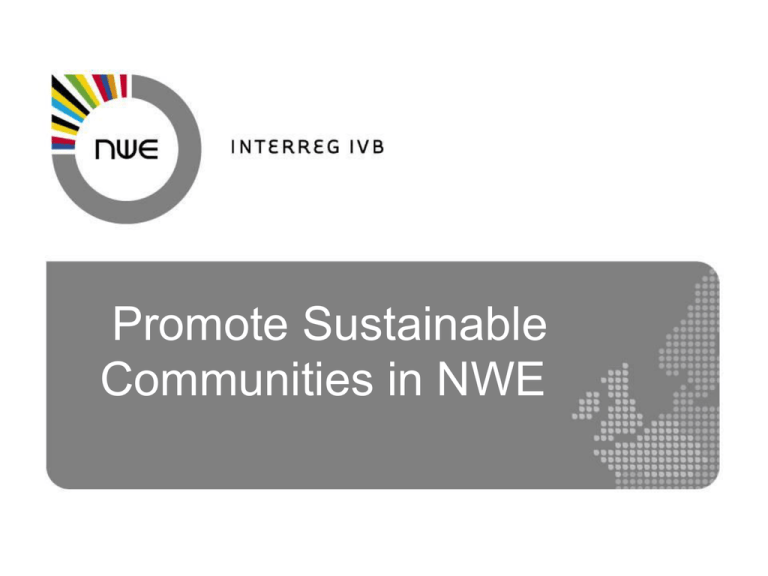
Promote Sustainable Communities in NWE The Lisbon Agenda (Strategy-2020) EU’s blueprint for competiveness and sustainable growth Lisbon Strategy Cohesion Policy Financial Resources (Structural Funds) Objectives, Structural Funds and instruments 2007-2013 Objectives Structural Funds and instruments Convergence ERDF ESF Regional Competitiveness and Employment ERDF ESF European territorial Cooperation ERDF Cohesion Fund Promoting Sustainable Communities Interreg NWE & Complementarity with other Funding Interreg IVB NWE Urbact II ESF Culture 2007 Interreg NWE & URBACT II Similarities & Differences Similarities Differences Both URBACT and INTERREG IVB promote a transnational approach to help improve urban development 1. URBACT focuses on policy and strategy development rather than concrete implementation projects (objective of INTERREG IVB). 2. URBACT is restricted to cities, whereas INTERREG focuses on "sustainable communities" more generally (including rural areas) INTERREG ADDED VALUE: 1. INTERREG can focus more on project that produce tangible outputs, rather than strategy development of studies as in URBACT. 2. INTERREG can adopt a wider regional approach (including urban-rural issues etc), rather than one focused explicitly on cities. Interreg NWE & CULTURE 2007 Similarities & Differences Similarities Differences 1. Transnational focus, including coverage of NWE area 2. Similar partnership model 3. Focus on sustainable, structured cooperation 4. Inclusion of cultural heritage as possible field of action 1. Exclusive focus on cultural sector 2. No explicit regional development Dimension 3. Wider geographical focus 4. Directly supports artistic productions INTERREG ADDED VALUE: 1. INTERREG supports projects aimed at specific creative outputs which have an explicit regional development dimension (for example use of culture and cultural industries for economic development) 2. INTERREG supports the development of "cultural infrastructure" Interreg NWE & European Social Fund Programmes Similarities & Differences Similarities Differences 1. Promote Transnational cooperation to 1. ESF has National Focus enhance sustainable economic activity 2. ESF focus on apply the lessons of 2. Same beneficiaries (public sector, NGOs previous EQUAL Programme and industry) 3. ESF promotes cooperation mainly between projects and national networks 4. ESF aims at improving social inclusion and human capital INTERREG ADDED VALUE: 1. INTERREG has a wider scope to support performance of regional development (including environmental challenges), while ESF focuses on social inclusion and human capital 2. INTERREG seeks for concrete projects with some investments; networking, training and studies (mainly funded by ESF) are acceptable only if they are linked to a wider strategy Interreg IVB NWE Niche for sustainable communities! →Need for transnational cooperation: tackle challenges that can not be addressed at national, regional or local level. →Tangible outputs: go beyond networking, plans, studies and training, implement investments, pilots, concrete actions that create wide territorial impact and leverage investment. →Capitalisation on previous results: consider what was already funded and delivered and build on the previous results. Capitalise on regional economic potential to increase attractiveness of cities, towns, rural areas. →Strong transnational partnerships: bring together key actors in the field and involve all relevant stakeholders to create change, influence policies and improve regional performance. →Targeted Calls: for “strategic” projects with thematic focus on demographic change & immigration challenges. Priority 4: Promoting strong and prosperous communities at transnational level Aim: To strengthen the attractiveness and performance of cities, towns, rural areas and regions through joint actions that will encourage sustainable economic activity and social cohesion. Objective 1: Objective 2: Objective 3: to promote the economic and social performance of cities, towns and rural areas; improve the environmental quality and attraction of towns and cities respond to the impacts of demographic change and migration on the NWE territory Identified Gaps in the Implementation of the Programme Available Funds under Priority 4 ERDF budget (2007-2013): 68 480 191€ ERDF requested (last call) 6 993 902 € ERDF allocated Calls 1 to 5 ERDF remaining 26 160 691€ ERDF allocated 35 325 598€ ERDF remaining ERDF requested (last Call) ERDF approved per Objective 18 000 000 16 258 782€ 16 000 000 14 000 000 13 370 254€ 6 000 000 4 000 000 5 696 562€ 3 projects 8 000 000 5 projects 10 000 000 5 projects 12 000 000 2 000 000 0 Economic & Social performance Environmental quality & Demographic change & Sustainability Migration ERDF Stakeholders participation How to fill in the Gaps: Successful stories Some successful stories: Objective 1 NB: Refer also to the printout “Approved projects” ! PROJECT WHY MANDIE Managing District Centers in North West Europe •First definition of DCM and DCM job profile, lecture tool kit→ joint development, local implementation and evaluation of model solutions •The partnership covers different sectors as it does not only comprise municipalities but also two universities and a national roof organization which bring specific expert knowledge into the partnership Some successful stories: Objective 2 NB: Refer also to the printout “Approved projects” ! PROJECT WHY Livinggreen •First jointly develop standards for .eu sustainable eco-renovation→ renovate cultural heritage buildings in the participating regions which will act as demonstration sites and host sustainability centers •Capitalize on the results of ECO-BUILD project (FP7 RTD) on eco building technologies and networks •Strong communication strategy guarantee knowledge transfer to Some successful stories: Objective 3 NB: Refer also to the printout “Approved projects” ! PROJECT WHY HDC •The seven regions taking part in this Health and cooperation are all facing the same Demographic demographic problems. Change •Create a transnational centre of excellence to experiment with and introduce innovative treatment for ageing population •The centre and its network will continue after the end of the project •Follow up of IIIB “Hospitals Cooperation” Thank you! Any questions
